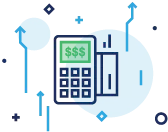Understanding payment processing systems can be a challenge due to technical jargon and terms that even experts in the field can’t wrap their heads around. This is apparent when looking at virtual terminals and payment gateways.
These terms are frequently used interchangeably, but they shouldn’t be. They signify different facets of online payment processing: the virtual terminal is where transactions are entered, whereas the payment gateway is the underlying mechanism for every online and manually entered transaction.
Below, find out the major differences between the two to gain a better understanding of the payment process. Let’s get into it!
What Is a Payment Gateway?
A payment gateway is any technology that allows merchants to accept card-not-present (CNP) transactions like online and MOTO payments. It serves as an intermediary between the customer’s bank and the merchant’s bank, facilitating the exchange of transaction data. When a customer initiates a payment on an eCommerce platform, the payment gateway encrypts the card details and forwards them to the acquiring bank for verification. If the payment is authorized, the funds are then transferred to the merchant’s bank account within the next few business days. This meticulous process assures the safety of sensitive information and protects against fraud.
Here’s a more detailed description of how a payment gateway works:
- Obtain a payment gateway from a payment service provider.
- A customer can initiate a payment online by inputting credit card details, in-store through swiping, dipping, or tapping, or via phone/email using a virtual terminal.
- The payment gateway captures, encrypts, and authenticates the cardholder’s data and then sends it to the payment processor.
- The card-issuing bank reviews and either approves or declines the transaction.
- The payment processor then communicates this decision (approval or denial) back to the payment gateway.
- Once the payment is settled, the funds move from the merchant account to the business’s bank account.
What Is a Virtual Terminal?
A virtual terminal is software, or in some instances, a payment gateway feature tailored to manually enter card information. While it’s related, a virtual terminal and a payment gateway are distinct. The virtual terminal primarily serves as a tool for merchants as customers typically don’t interact with it. It acts as a dashboard, providing insights into the back-end of transactions within your merchant account. Merchants can key in transactions, create and send invoices, and accept payments over the phone or by email.
With a virtual terminal, there might be an option to use additional hardware, like an EMV-enabled credit card reader, but it’s not always necessary.
Here’s a more detailed description of how a virtual terminal works:
- To initiate the process, a merchant accesses the virtual terminal interface and either sends a digital invoice to a customer or manually enters transaction details.
- The cardholder can either pay through the provided invoice link or directly provide their card information to the merchant.
- The virtual terminal processes the payment.
- Following a successful transaction, the merchant receives confirmation, and the cardholder is emailed a receipt.
What’s the Difference Between a Virtual Terminal and a Payment Gateway?

There are significant distinctions between a virtual terminal and a payment gateway. For one, a virtual terminal is a non-customer-facing software that enables merchants to manually enter a customer’s payment information into their system. On the other hand, a payment gateway is a POS software where customers enter their card information themselves. This can be achieved by tapping, swiping, inserting, or selecting saved payment methods on an eCommerce site.
With a payment gateway, there’s no need for the merchant to manually input transaction details, as customers do it themselves. However, when using a virtual terminal, the merchant is responsible for entering the customer’s information. As you might have figured, this setup is particularly useful for Mail Order/Telephone Order (MOTO) payments. Consequently, many merchants opt to incorporate both a payment gateway and a virtual terminal in their operations.
Does My Business Need a Payment Gateway or a Virtual Terminal?
Each solution comes with different perks. For example, a payment gateway enables merchants to accept online payments with credit cards, debit cards, and ACH. Additionally, it offers features including recurring billing and integration with accounting software. In contrast, a virtual terminal facilitates the payment process for mail and telephone orders, as well as off-site events. It also allows merchants to save money since there are no upfront hardware expenses. So, a virtual terminal and payment gateway are both worth considering as a package.
Additionally, using a virtual terminal involves manual input of cardholder information. If you’re unwilling or unable to handle this yourself, you’ll need extra staff. If you lack the necessary manpower and time, a virtual terminal might not be ideal for your business.
How to Get a Payment Gateway and/or Virtual Terminal
Since a virtual terminal is simply a feature of a payment gateway, trying to secure both is fairly simple with the help of a merchant service provider. These providers offer merchant accounts that include a payment gateway solution at a discounted price. On top of that, merchant service providers pair you with payment experts to create a custom payment solution for your business so you can focus on the important parts of your business.
Level up your online business!
Accepting payments has never been easier.
Satisfaction
Frequently Asked Questions (FAQs)
Can my business accept payments without a gateway or virtual terminal?
It depends on the type of payments you want to process. For cash payments, you don’t need a payment gateway or a virtual terminal. However, if you aim to process credit card payments, then a payment gateway is essential. In contrast, a virtual terminal is optional and is primarily used for payments accepted over the phone, mail, and email.
What’s the difference between a payment gateway and a payment processor?
The payment gateway is the software that facilitates a payment transaction. Whereas the payment processor handles the movement of funds to the respective destinations as needed.
What is an example of a virtual terminal?
Payment service providers such as Square and Stripe offer virtual terminals. There are also payment gateway providers like Authorize.net that include a virtual terminal as a feature of their payment gateway. While some of them come free of charge, others, require a monthly fee for the virtual terminal and/or for the software itself.
What are the types of payment gateway systems?
There are four payment gateway systems: Hosted payment gateways, self-hosted payment gateways, API-hosted payment gateways, and local bank integration payment gateways.
What is the difference between a POS terminal and a virtual terminal?
A POS terminal is a physical device that enables in-person credit card payments when a customer swipes, dips, or taps their card. On the other hand, a virtual terminal is not a payment gateway in itself. It is a dashboard where merchants can manually input a customer’s card details to process a transaction, commonly used for Mail Order/Telephone Order (MOTO) payments.






